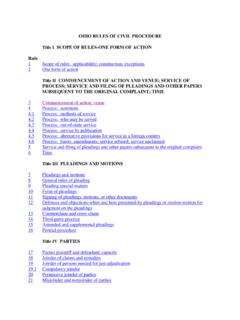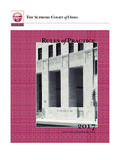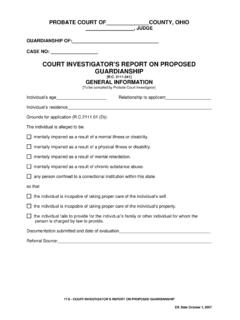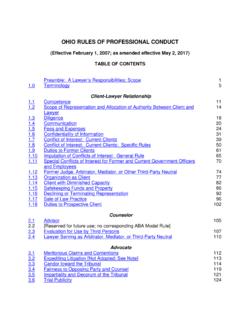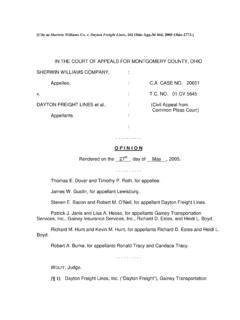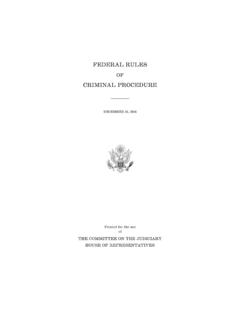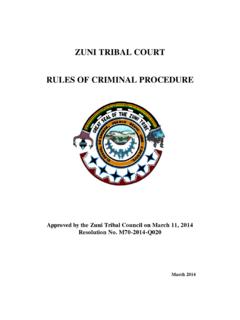Transcription of Rules of Criminal Procedure - Supreme Court of Ohio
1 ohio Rules OF Criminal Procedure . Rule 1 Scope of Rules : applicability; construction; exceptions 2 Definitions 3 Complaint 4 Warrant or summons; arrest Optional Procedure in minor misdemeanor cases 5 Initial appearance, preliminary hearing 6 The grand jury 7 The indictment and the information 8 Joinder of offenses and defendants 9 Warrant or summons upon indictment or information 10 Arraignment 11 Pleas, rights upon plea 12 Pleadings and motions before trial: defenses and objections Notice of alibi 13 Trial together of indictments or informations or complaints 14 Relief from prejudicial joinder 15 Deposition 16 Discovery and inspection 17 Subpoena 18 Venue and change of venue 19 Magistrates 20 [Reserved]. 21 Transfer from common pleas Court for trial 22 Recording of proceedings 23 Trial by jury or by the Court 24 Trial by jurors 25 Disability of a judge 26 Substitution of photographs for physical evidence 27 Proof of official record; judicial notice: determination of foreign law 28 [Reserved].
2 29 Motion for acquittal 30 Instructions 31 Verdict 32 Sentence Withdrawal of guilty plea Presentence investigation Revocation of community release 33 New trial 34 Arrest of judgment 35 Post-conviction petition Rule 36 Clerical mistakes 37 [Reserved]. 38 [Reserved]. 39 [Reserved]. 40 [Reserved]. 41 Search and seizure 42 Capital Cases and Post-Conviction Review of Capital Cases 43 Presence of the defendant 44 Assignment of counsel 45 Time 46 Bail 47 Motions 48 Dismissal 49 Service and filing of papers 50 Calendars 51 Exceptions unnecessary 52 Harmless error and plain error 53 [Reserved]. 54 Amendment of incorporated civil Rules 55 Records 56 [Reserved]. 57 Rule of Court ; Procedure not otherwise specified 58 Forms 59 Effective date 60 Title Appendix of Forms RULE 1. Scope of Rules : Applicability; Construction; Exceptions (A) Applicability. These Rules prescribe the Procedure to be followed in all courts of this state in the exercise of Criminal jurisdiction, with the exceptions stated in division (C) of this rule.
3 (B) Purpose and construction. These Rules are intended to provide for the just determination of every Criminal proceeding. They shall be construed and applied to secure the fair, impartial, speedy, and sure administration of justice, simplicity in Procedure , and the elimination of unjustifiable expense and delay. (C) Exceptions. These Rules , to the extent that specific Procedure is provided by other Rules of the Supreme Court or to the extent that they would by their nature be clearly inapplicable, shall not apply to Procedure (1) upon appeal to review any judgment, order or ruling, (2) upon extradition and rendition of fugitives, (3) in cases covered by the Uniform Traffic Rules , (4) upon the application and enforcement of peace bonds, (5) in juvenile proceedings against a child as defined in Rule 2(D) of the Rules of Juvenile Procedure , (6) upon forfeiture of property for violation of a statute of this state, or (7) upon the collection of fines and penalties.
4 Where any statute or rule provides for Procedure by a general or specific reference to the statutes governing Procedure in Criminal actions, the Procedure shall be in accordance with these Rules . [Effective: July 1, 1973; amended effective July 1, 1975; July 1, 1996.]. RULE 2. Definitions As used in these Rules : (A) "Felony" means an offense defined by law as a felony. (B) "Misdemeanor" means an offense defined by law as a misdemeanor. (C) "Serious offense" means any felony, and any misdemeanor for which the penalty prescribed by law includes confinement for more than six months. (D) "Petty offense" means a misdemeanor other than a serious offense. (E) "Judge" means judge of the Court of common pleas, juvenile Court , municipal Court , or county Court , or the mayor or mayor's Court magistrate of a municipal corporation having a mayor's Court . (F) "Magistrate" means any person appointed by a Court pursuant to Crim. R. 19. "Magistrate" does not include an official included within the definition of magistrate contained in section of the Revised Code, or a mayor's Court magistrate appointed pursuant to section of the Revised Code.
5 (G) "Prosecuting attorney" means the attorney general of this state, the prosecuting attorney of a county, the law director, city solicitor, or other officer who prosecutes a Criminal case on behalf of the state or a city, village, township, or other political subdivision, and the assistant or assistants of any of them. As used in Crim. R. 6, "prosecuting attorney" means the attorney general of this state, the prosecuting attorney of a county, and the assistant or assistants of either of them. (H) "State" means this state, a county, city, village, township, other political subdivision, or any other entity of this state that may prosecute a Criminal action. (I) "Clerk of Court " means the duly elected or appointed clerk of any Court of record, or the deputy clerk, and the mayor or mayor's Court magistrate of a municipal corporation having a mayor's Court . (J) "Law enforcement officer" means a sheriff, deputy sheriff, constable, municipal police officer, marshal, deputy marshal, or state highway patrolman, and also means any officer, agent, or employee of the state or any of its agencies, instrumentalities, or political subdivisions, upon whom, by statute, the authority to arrest violators is conferred, when the officer, agent, or employee is acting within the limits of statutory authority.
6 The definition of "law enforcement officer" contained in this rule shall not be construed to limit, modify, or expand any statutory definition, to the extent the statutory definition applies to matters not covered by the Rules of Criminal Procedure . [Effective: July 1, 1973; amended effective July 1, 1976; July 1, 1990.]. RULE 3. Complaint The complaint is a written statement of the essential facts constituting the offense charged. It shall also state the numerical designation of the applicable statute or ordinance. It shall be made upon oath before any person authorized by law to administer oaths. [Effective: July 1, 1973.]. RULE 4. Warrant or Summons; Arrest (A) Issuance. (1) Upon complaint. If it appears from the complaint, or from an affidavit or affidavits filed with the complaint, that there is probable cause to believe that an offense has been committed, and that the defendant has committed it, a warrant for the arrest of the defendant, or a summons in lieu of a warrant, shall be issued by a judge, magistrate, clerk of Court , or officer of the Court designated by the judge, to any law enforcement officer authorized by law to execute or serve it.
7 The finding of probable cause may be based upon hearsay in whole or in part, provided there is a substantial basis for believing the source of the hearsay to be credible and for believing that there is a factual basis for the information furnished. Before ruling on a request for a warrant, the issuing authority may require the complainant to appear personally and may examine under oath the complainant and any witnesses. The testimony shall be admissible at a hearing on a motion to suppress, if it was taken down by a Court reporter or recording equipment. The issuing authority shall issue a summons instead of a warrant upon the request of the prosecuting attorney, or when issuance of a summons appears reasonably calculated to ensure the defendant's appearance. (2) By law enforcement officer with warrant. In misdemeanor cases where a warrant has been issued to a law enforcement officer, the officer, unless the issuing authority includes a prohibition against it in the warrant, may issue a summons in lieu of executing the warrant by arrest, when issuance of a summons appears reasonably calculated to ensure the defendant's appearance.
8 The officer issuing the summons shall note on the warrant and the return that the warrant was executed by issuing summons, and shall also note the time and place the defendant shall appear. No alias warrant shall be issued unless the defendant fails to appear in response to the summons, or unless subsequent to the issuance of summons it appears improbable that the defendant will appear in response to the summons. (3) By law enforcement officer without a warrant. In misdemeanor cases where a law enforcement officer is empowered to arrest without a warrant, the officer may issue a summons in lieu of making an arrest, when issuance of a summons appears reasonably calculated to ensure the defendant's appearance. The officer issuing the summons shall file, or cause to be filed, a complaint describing the offense. No warrant shall be issued unless the defendant fails to appear in response to the summons, or unless subsequent to the issuance of summons it appears improbable that the defendant will appear in response to the summons.
9 (B) Multiple issuance; sanction. More than one warrant or summons may issue on the same complaint. If the defendant fails to appear in response to summons, a warrant or alias warrant shall issue. (C) Warrant and summons: form. (1) Warrant. The warrant shall contain the name of the defendant or, if that is unknown, any name or description by which the defendant can be identified with reasonable certainty, a description of the offense charged in the complaint, whether the warrant is being issued before the defendant has appeared or was scheduled to appear, and the numerical designation of the applicable statute or ordinance. A copy of the complaint shall be attached to the warrant. (a) If the warrant is issued after the defendant has made an initial appearance or has failed to appear at an initial appearance, the warrant shall command that the defendant be arrested and either of the following: (i) That the defendant shall be required to post a sum of cash or secured bail bond with the condition that the defendant appear before the issuing Court at a time and date certain.
10 (ii) That the defendant shall be held without bail until brought before the issuing Court without unnecessary delay. (b) If the warrant is issued before the defendant has appeared or is scheduled to appear, the warrant shall so indicate and the bail provisions of 46 shall apply. (2) Summons. The summons shall be in the same form as the warrant, except that it shall not command that the defendant be arrested, but shall order the defendant to appear at a stated time and place and inform the defendant that he or she may be arrested if he or she fails to appear at the time and place stated in the summons. A copy of the complaint shall be attached to the summons, except where an officer issues summons in lieu of making an arrest without a warrant, or where an officer issues summons after arrest without a warrant. (D) Warrant and summons: execution or service; return. (1) By whom. Warrants shall be executed and summons served by any officer authorized by law.
